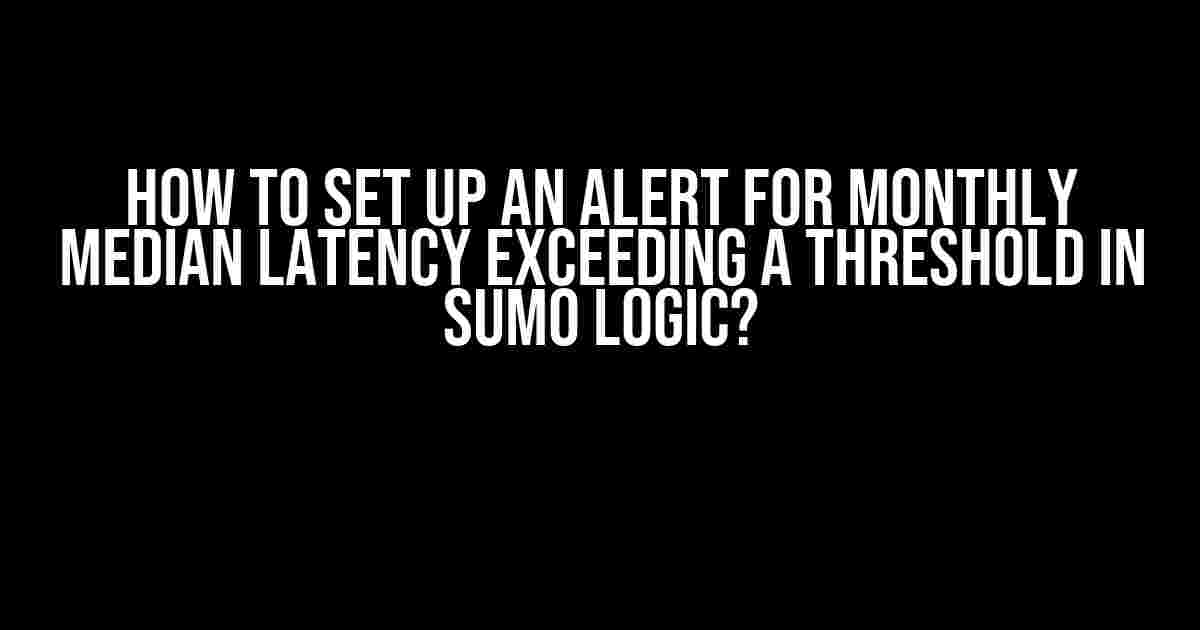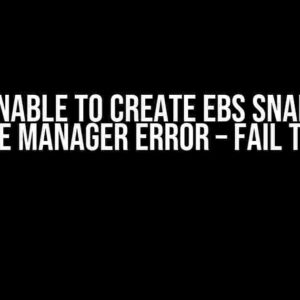Welcome to this comprehensive guide on setting up an alert for monthly median latency exceeding a threshold in Sumo Logic! In this article, we’ll take you through a step-by-step process to help you get started with creating this alert. By the end of this tutorial, you’ll be able to monitor your application’s performance and receive timely notifications when the monthly median latency exceeds a predetermined threshold.
- What is Median Latency?
- Why is it Important to Monitor Median Latency?
- Prerequisites
- Step 1: Create a New Alert
- Step 2: Configure the Alert
- Step 3: Define the Query
- Step 4: Configure the Alert Threshold
- Step 5: Choose the Alert Type
- Step 6: Save and Test the Alert
- Step 7: Schedule the Alert
- Conclusion
- Conclusion
What is Median Latency?
Before we dive into the tutorial, let’s quickly understand what median latency is. Median latency is a measure of the middle value in a dataset of latency times. It’s a more robust metric than average latency, as it’s less affected by extreme outliers. In the context of Sumo Logic, median latency is calculated as the middle value of the latency times of all requests within a given time range.
Why is it Important to Monitor Median Latency?
Monitoring median latency is crucial for ensuring your application’s performance meets user expectations. Here are a few reasons why:
- Median latency directly impacts user experience. High latency can lead to frustrated users, increased bounce rates, and decreased conversions.
- Identifying and resolving latency issues proactively helps maintain a competitive edge in the market.
- Monitoring median latency helps you detect anomalies and trends in your application’s performance, enabling data-driven decisions.
Prerequisites
Before you start setting up the alert, make sure you have the following:
- A Sumo Logic account with the necessary permissions to create alerts.
- A data source (e.g., AWS, Azure, GCP, or on-premises logs) sending latency data to Sumo Logic.
- A basic understanding of Sumo Logic’s query language and aggregation operators.
Step 1: Create a New Alert
Log in to your Sumo Logic account and navigate to the Alerts & Notifications section. Click on the New Alert button.
Step 2: Configure the Alert
In the Create Alert page, enter a name and description for your alert. For example:
Name: Monthly Median Latency Alert Description: Alerts when monthly median latency exceeds 500ms
Step 3: Define the Query
In the Define Query section, enter the following query:
_index=sumo-logs | parse " latency:*" as latency | latency as num | agg median(latency) as median_latency | filter median_latency > 500 | where _timeslice = 1m | group by _timeslice, _window
This query:
- Filters logs with the keyword “latency” and extracts the latency value using the
parseoperator. - Converts the latency value to a numeric data type using the
as numoperator. - Filters the results to only include data points where the median latency exceeds 500ms.
- Groups the results by minute (
_timeslice = 1m) and window (_window).
Step 4: Configure the Alert Threshold
In the Threshold section, select Static and enter the following values:
Threshold: 500 Unit: ms
This sets the alert threshold to 500ms. When the median latency exceeds this value, the alert will trigger.
Step 5: Choose the Alert Type
In the Alert Type section, select Notification and choose the notification method (e.g., email, Slack, or PagerDuty) and the notification recipients.
Step 6: Save and Test the Alert
Click the Save button to save the alert. You can test the alert by clicking the Test button.
Step 7: Schedule the Alert
In the Schedule section, select the Monthly option and set the schedule to run at the beginning of each month.
Conclusion
That’s it! You’ve successfully set up an alert for monthly median latency exceeding a threshold in Sumo Logic. From now on, you’ll receive timely notifications whenever your application’s median latency exceeds the predetermined threshold, enabling you to take proactive measures to optimize performance and ensure a better user experience.
Best Practices
Here are some best practices to keep in mind when configuring alerts in Sumo Logic:
- Set alert thresholds based on historical data and performance baselines.
- Use meaningful names and descriptions for alerts to ensure easy identification.
- Test alerts regularly to ensure they’re functioning as expected.
- Fine-tune alert queries to minimize false positives and negatives.
Troubleshooting Tips
If you encounter issues with your alert, here are some troubleshooting tips:
- Verify that the data source is sending latency data to Sumo Logic.
- Check the alert query for syntax errors and typos.
- Ensure the alert threshold is set correctly and within reasonable limits.
- Review the alert schedule to ensure it’s set to run at the correct frequency.
Conclusion
By following this step-by-step guide, you’ve successfully set up an alert for monthly median latency exceeding a threshold in Sumo Logic. Remember to regularly review and refine your alerts to ensure they’re meeting your performance monitoring needs. Happy monitoring!
| Keyword | Description |
|---|---|
| Median Latency | The middle value in a dataset of latency times |
| Sumo Logic | A cloud-based log management and analytics platform |
| Aggregation Operators | Operators used to perform calculations on data, such as median, average, and sum |
Note: This article is for educational purposes only and is not affiliated with Sumo Logic or any other third-party vendor.
Frequently Asked Question
Get ready to set up an alert for monthly median latency exceeding a threshold in Sumo Logic!
What is the purpose of setting up an alert for monthly median latency exceeding a threshold in Sumo Logic?
Setting up an alert for monthly median latency exceeding a threshold in Sumo Logic allows you to proactively monitor and identify potential performance issues in your application, ensuring a better user experience. It enables you to receive timely notifications and take corrective actions to prevent latency spikes from impacting your business.
How do I create a search query to calculate the monthly median latency in Sumo Logic?
You can create a search query using the `_timeslice` function in Sumo Logic. The query would look like this: ` latency < 1m | _timeslice 1m | percentile(latency, 50)` . This query calculates the median latency for each 1-minute time slice.
How do I set up an alert for monthly median latency exceeding a threshold in Sumo Logic?
To set up an alert, follow these steps: 1) Create a new alert, 2) Select the search query you created earlier, 3) Set the aggregation to `max`, 4) Choose a threshold value (e.g., 500ms), 5) Set the trigger to `greater than`, and 6) Configure the notification settings as per your requirement.
Can I customize the alert notification in Sumo Logic?
Yes, you can customize the alert notification in Sumo Logic. You can choose from various notification options, such as email, webhook, or HTTP, and configure the notification content to include relevant information about the alert, such as the latency value, timestamp, and more.
How often will I receive notifications for monthly median latency exceeding a threshold in Sumo Logic?
You will receive notifications only when the monthly median latency exceeds the threshold you set. The frequency of notifications depends on the aggregation window and the threshold value. If the threshold is exceeded multiple times within the aggregation window, you will receive only one notification.








